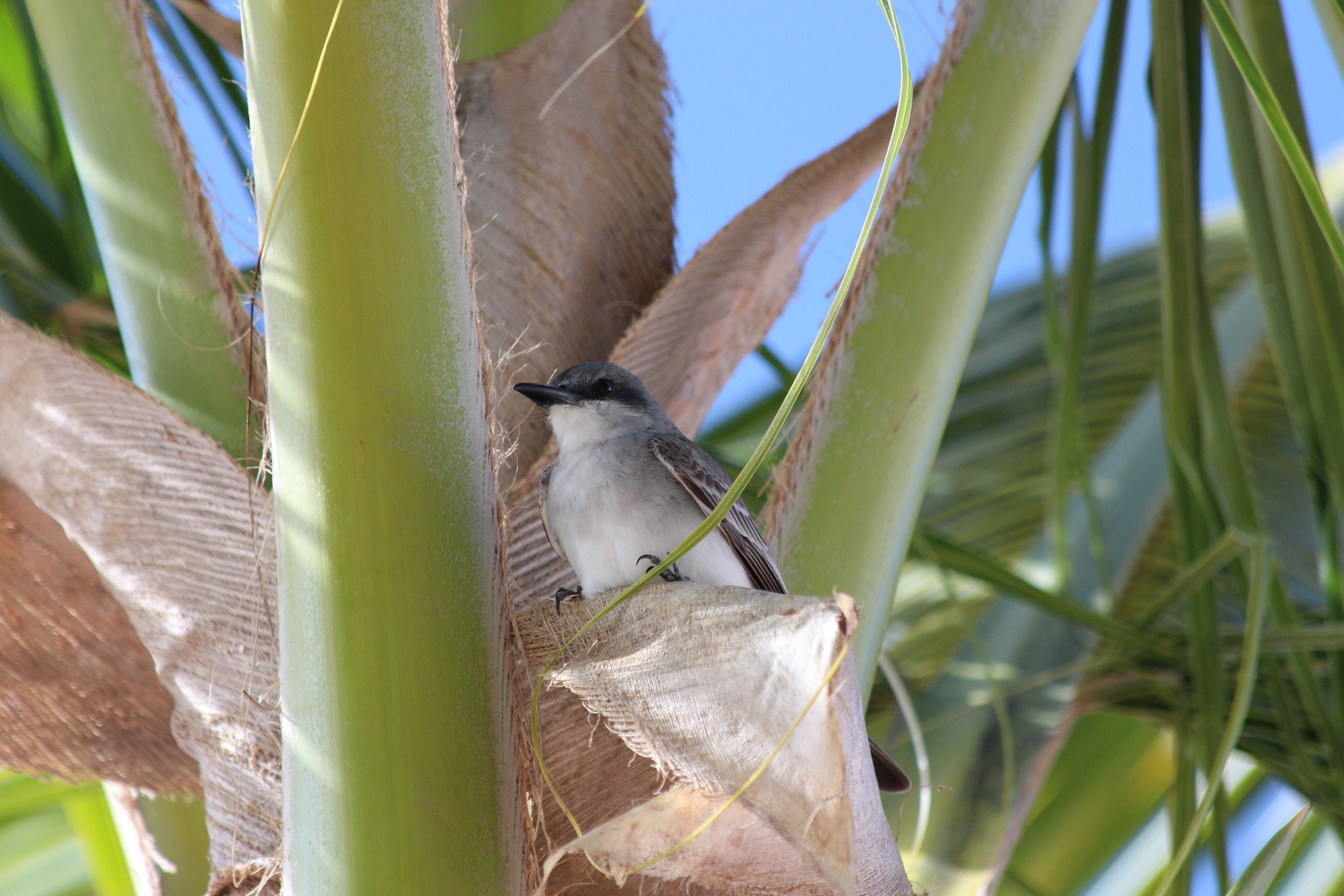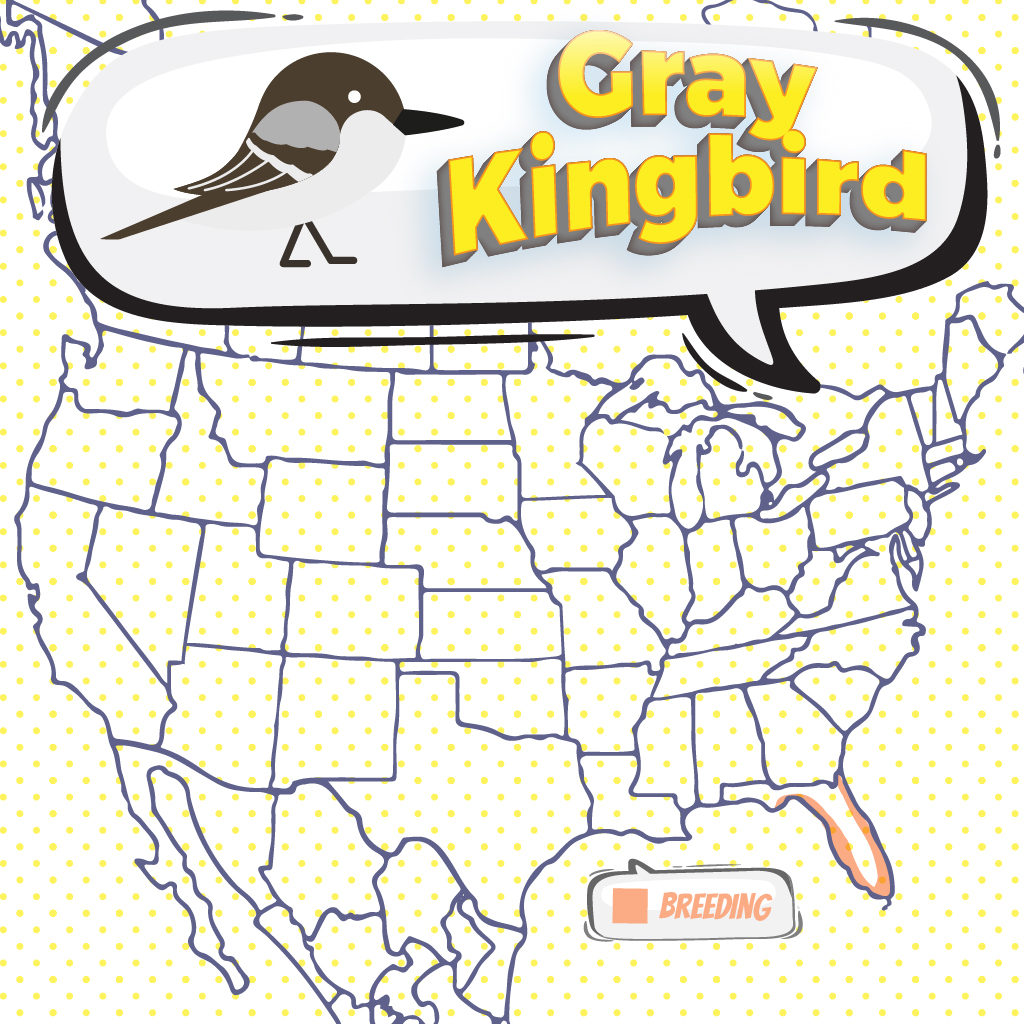
Gray Kingbird
A Gray Kingbird is a fun bird to see while bird watching. Below are some tips to help you identify Gray Kingbirds. We have also put together a list of fun Gray Kingbird t-shirts, Gray Kingbird bird patches, bird houses, bird feeders, binoculars, stickers and other fun bird watching items.
About the Gray Kingbird
Also known as petchary, Pierre, or white-breasted kingbird, the Gray Kingbird is widespread in the Caribbean. They are commonly found in Colombia, Trinidad, Tobago, and Venezuela. They breed mainly in Florida and Central America wintering on the Caribbean coast and northern South America. Human development has invaded their initial habitats but they have adapted and become tolerant of humans. Some of their distinctive features include:
Description and Identification
In rare cases, Gray Kingbirds can be mistaken for stray Loggerhead Kingbirds due to
their similar appearance. Adult Gray Kingbirds have gray upperparts, primarily white
underparts with a pale-yellow tint on their belly and undertail coverts along with a dark
tail. They boast large, black bills with hooked tips along with grayish-black masks
running along with the eyes. They also have inconspicuous reddish-orange plumes on the
crown. Males and females are similar in appearance. Juveniles can be distinguished by
the rufous coloring along with their tails, wing coverts, and rumps. The adults are regular
sized Kingbirds measuring an average of 9.1 inches in length and weighing between
1.3-1.8 oz. They are known to be conspicuous birds with a loud rolling trill as their call.
Gray Kingbird Pattern
These large flycatchers have gray upperparts, mostly white underparts, black masks,s and brown to dark brown eyes. Their legs are primarily black. When in flight their tails portray a dominant brown-black pattern both on the upper tail and the under the tail.
Gray Kingbird Size
Adult Gray Kingbirds are average-sized kingbirds. The bill is fairly long and heavy.
The relative size of both sexes:
- Length range: 9 in (23 cm)
- Weight: 1.5 oz (43 g)
- Wingspan range: 14.5-16 in (37-41 cm)

Gray Kingbird Behavior
They are strongly territorial birds that become aggressive when an intruder trespasses on their territory. Gray Kingbirds can often be seen perching in the open field giving loud, arresting calls. They forage by watching from an unexpected position and then jump to catch insects. They also hover and catch insects just above the water surface.
What Gray Kingbird Eat
The primary diet of Gray Kingbirds includes both large and small insects such as
grasshoppers, bees, wasps, beetles, dragonflies, etc. They also prey on lizards. They are known to feed on various berries and small fruits found in close proximity to their
habitats. During certain seasons, berries and smalls fruits might constitute more than
1/5 th of their diet. In a few parts of the Caribbean, there have been sightings of Gray
Kingbirds preying on smaller hummingbirds as well. They forage for food perched atop
high trees or buildings and sally out to catch their prey. They are also known to catch
their prey on or just above the surface of the water while still in the air.
They predominantly feed on insects and some berries. They feed on a variety of insects such as wasps, beetles, caterpillars, etc. also feed on lizards and can be seen hunting hummingbirds along the Caribbean coast. Gray kingbirds feed on berries in certain seasons which make up one-fifth of their diet.
Where Gray Kingbirds Live
Gray Kingbirds are coastal, tropical, and neotropical birds. They inhabit various spaces
such as undisturbed mangroves, shrubs, trees such as oak and palm. In several
countries including the United States, with development and infrastructure taking over
several of their habitats, they have adapted and are now also known to inhabit open
fields as well as trees in urban and suburban areas near the coast. In the Caribbean,
they are found to reside in a similar mixture of habitats ranging from mangroves to open
fields, as well as woodlands near the coastal areas. Gray Kingbirds’ habitats are
generally dry and open but are usually associated with water. Akin to various other
species of Kingbirds, Gray Kingbirds are also known to defend their territories from
intruders such as other birds, animals, and humans.
The Gray Kingbirds thrive in both open and semi-open areas with tall trees and scattered bushes. They frequent areas near coastal beaches, grasslands, forest edges, parks, towns, and woodlands with oak and pine. They are commonly seen in mangrove forests, wintering in the tropics of central and South America. They lay their eggs on elevated grounds ideally 4-50 ft. above the ground.
Range and Migration

Gray Kingbirds are tyranted flycatchers occurring mainly in the Caribbean through Central
America, Venezuela, and West Indies. They were first identified inhabiting the island of
Hispaniola along with Santo Domingo. In the United States, they are known to inhabit
the coastlines of the state of Florida along with parts of Georgia, South Carolina, and
Alabama. Gray Kingbirds restrict their habitats to tropical and coastal areas. The
Northern populations are known to be migratory, moving south towards the Caribbean
for the winter.
Gray Kingbird Lifecycle
Female Gray Kingbirds lay around 3-5 eggs in a nest made of twigs, roots, and grass. The female incubates the eggs for 16-18 days. Both parents feed the young ones after they hatch. The age at which they take flight is not well known. Their lifespan is thought to be about six years in the wild.
Gray Kingbird Nesting
Commonly, Gray Kingbirds build nests a few feet above the ground or water but can
also nest in high trees such as oaks and palms. In the urban setting, they are known to
build nests on wires near poles. Their breeding or nesting behavior is poorly known as
they aggressively defend their nests, attacking humans who try to get close to them. Their
nests are built with twigs, rootlets, etc., and are lined with fine grass. The nests are built
loosely allowing the eggs to be spotted from below.
Ornithology
Bird Watching Academy & Camp Subscription Boxes
At Bird Watching Academy & Camp we help kids, youth, and adults get excited and involved in bird watching. We have several monthly subscription boxes that you can subscribe to. Our monthly subscription boxes help kids, youth, and adults learn about birds, bird watching, and bird conservation.
Bird Watching Binoculars for Identifying Gray Kingbirds
The most common types of bird watching binoculars for viewing Gray Kingbirds are 8×21 binoculars and 10×42 binoculars. Bird Watching Academy & Camp sells really nice 8×21 binoculars and 10×42 binoculars. You can view and purchase them here.
Gray Kingbird T-shirts
If you love the Gray Kingbird you should purchase a Bird Watching Academy & Camp T-shirt. To help support bird conservation we donate 10 percent to bird conservation activities.
Gray Kingbird Iron On Patches
Kids, Youth, and Adults love to collect our Bird Watching Academy & Camp iron-on patches. Our bird-watching patches help you keep track of the birds you have seen and identified. You can also display the patches on our Bird Watching Academy & Camp banners.
The Gray Kingbird is a great iron-on patch to start your collection with. The patches are durable and can be sewn on or ironed on to just about anything.
Gray Kingbird Stickers
Stickers are a great way for you to display your love for bird watching and the Gray Kingbird. We sell a monthly subscription sticker pack. The sticker packs have 12 bird stickers. These sticker packs will help your kids learn new birds every month.
Bird Feeders For Gray Kingbird
There are many types of bird feeders. Here are our favorite bird feeders for your backyard. We use all of these bird feeders currently. Kids will have a great time watching birds eat at these bird feeders. Using this collection of bird feeders will provide a wide variety and many types of birds.
Best Bird Houses for Gray Kingbird
There are many types of birdhouses. Building a birdhouse is always fun but can be frustrating. These 4 birdhouses have become our favorites. Getting a birdhouse for kids to watch birds grow is always fun. We spent a little extra money on these birdhouses but they have been worth the higher price and look great.










